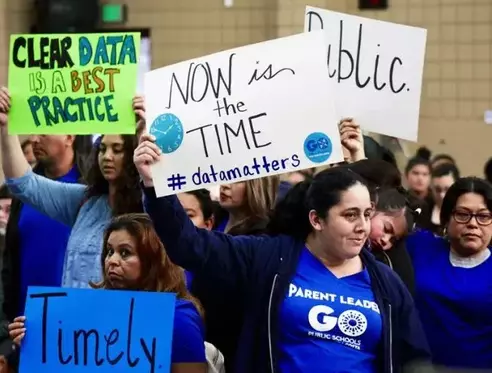Nope, today we are not discussing the mystical illuminati pyramid (to read up on conspiracy theories you’ve got to go somewhere else). Instead, we’re talking about an even more powerful tool: the engagement pyramid.
An engagement pyramid is a visual representation of all the audiences your organization interacts with and the roles you need them to play to achieve your mission. The engagement pyramid provides a lens for your constituent data and can highlight gaps in your campaigns or programs. It can also help you capitalize on existing resources and break down silos in your organization.
You might know the engagement pyramid by other names (e.g. ladders of engagement, circles of love, etc.). But the engagement framework that we love most is the pyramid, developed at Groundwire and thoughtfully documented by Gideon Rosenblatt. It borrows from tried-and-true organizing and fundraising practices as well as the good ideas of many smart people, and it’s a powerful tool for any organization that wants to get better at engagement.
We create an engagement pyramid with almost every client we work with. The pyramid informs the technology we build and it is the center of our engagement tracking app, StepUp.
With a well-constructed engagement pyramid, an organization knows exactly what activities or qualities define supporters at each level.
To use this powerful tool effectively, your organization first needs to tackle four steps:
- Create a Theory of Change for your organization (your board and every member of your staff should understand your theory of change and be able to explain it)
- Define all the audiences that relate to your theory of change (legislators? property owners? press? parents? business leaders? voters?)
- Define all the roles that you need these audiences to play in order to achieve your mission
- Honestly weigh your roles. (It’s often helpful to compare the value of activities to the value of a contribution…for a $10,000 contribution, could you hire an intern to take on the duties of a weekly volunteer? If so, volunteering weekly would put a supporter in the same level as a $10K donor.)
(Any of these steps seem confusing? Don’t worry we are here to help, just give us a shout.)
After you have tackled these four steps it’s time to build your engagement pyramid. But before we dive right in here are some pro tips for pyramid building:
- Keep your levels simple (a complicated pyramid will never get used). The number of levels you employ should be based on your use case, but fewer than three levels isn’t that helpful, and more than eight is unwieldy for most organizations.
- Keep your levels trackable (you want to be able to actually count all the people in each level)
- Name your levels (staff will forget what the definition of level 4 is). We offer some standard level names below, but encourage you to use vocabulary that is appropriate for your organization.
- Remember that your pyramid must relate to your theory of change (you don’t want busy work in your pyramid)
The Engagement Pyramid Levels Defined!

Before we go on with definition guidelines for each level, we want to repeat our props to Gideon Rosenblatt as the definitions below are based on his original engagement pyramid document.
Engagement Level 0 “Observers”
(bottom of the engagement pyramid)
Observers are the folks at the bottom of your pyramid who are interested in your work, but you don’t yet have their contact information. These may be your media impressions from paid or earned media, unique website visitors, social media fans, etc. The Observer level is for people who aren’t yet in your database, but you know they exist and are the pool from which your supporters emerge.
Engagement Level 1 “Followers”
Followers are the folks who have raised their hands to become part of your movement. These people have given you their contact information (maybe they’ve signed up for your email list), but they haven’t yet taken any further action or made a donation.
Engagement Level 2 “Endorsers”
Endorsers believe in your mission and trust your organization enough to sign a petition or take other small actions to endorse your organization. We often include modest financial contributions in this level.
Engagement Level 3 “Contributors”
Contributors give a significant amount of time or money to your organization, but they have yet to take on a leadership role. Depending on your organization, these contributors may have: volunteered, contributed content, attended fee-based events and conferences, taken elevated action and/or made a membership or higher level financial contribution.
Engagement Level 4 “Owners”
Owners believe in your organization and your mission so much that they take on meaningful responsibility and authority for reaching your organization’s goals. Owners are your spokespeople, super volunteers, major donors.
Engagement Level 5 “Champions”
Champions are the five or ten people your organization’s Executive Director would call if something big was about to happen. Champions are the rockstars on your board or in other leadership positions. They are the special donors of time, money, influence, and other resources to your organization.
**Make sure all the levels in your pyramid are helping you reach your mission. Your supporters are your best source of power for changing the world – make sure you’ve thought through all of the roles they can play and are providing the support and tools for them to play those roles.
Creating an engagement pyramid is not rocket science, but it can be tricky to create clear, trackable, levels for your organization. We recommend taking some time to develop your pyramid and having several working meetings with all the department leaders in your organization. Give us a shout if you need help.
Now comes the power
While process of defining an Engagement Pyramid has value, the real power comes when you can apply it to the people in your organization and use the data to make decisions.
There is so much you can do with your engagement pyramid, here are just a few:
- Count and track all the folks in at each level of your pyramid
- Watch what levels are growing or shrinking and run experiments to bolster growth
- Test efforts at moving people up your pyramid
- Test how best to engage each level
Tracking your pyramid levels to make sure you have the data you need to make great engagement decisions is why we made StepUp. StepUP is a Salesforce App that gives every contact in your database and engagement score based on your engagement pyramid. With StepUp’s built in dashboards, you can see how many people you have at each engagement level, engagement trends over time, and which campaigns have been the most successful at deepening engagement.




